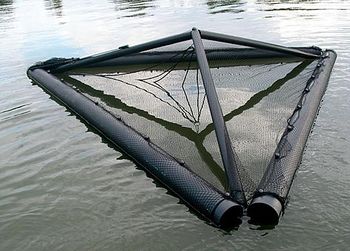Aquaculture: Difference between revisions
mNo edit summary |
No edit summary |
||
| Line 2: | Line 2: | ||
Aquaculture is farming on water. Many of the same principles as farming on land apply, and there can also be synergy between land-based and water-based farming - for example, chickens and ducks will find forage at the edge of the pond. In any system of agriculture based on the interconnections between different organisms, the most productive area will be the edge between two different environments. Therefore, when integrating aquaculture and agriculture it is best to maximize the edge length of the pond; a square pond is a bad idea; one with crinkly edges is much better. | Aquaculture is farming on water. Many of the same principles as farming on land apply, and there can also be synergy between land-based and water-based farming - for example, chickens and ducks will find forage at the edge of the pond. In any system of agriculture based on the interconnections between different organisms, the most productive area will be the edge between two different environments. Therefore, when integrating aquaculture and agriculture it is best to maximize the edge length of the pond; a square pond is a bad idea; one with crinkly edges is much better. | ||
Because fish are cold-blooded, and because water provides buoyancy so they do not have to expend energy to hold themselves up all the time, they are much more energy-efficient organisms than land based animals. Nutrients dissolved in water are more readily absorbed by organisms. For these reasons, aquaculture is 4-20 times more efficient than land-based agriculture in terms of the energy used to make a unit of food. You can, for example, get 12-15kg of food per year from a single taro plant. | Because fish are cold-blooded, and because water provides buoyancy so they do not have to expend energy to hold themselves up all the time, they are much more energy-efficient organisms than land based animals. Nutrients dissolved in water are more readily absorbed by organisms. For these reasons, aquaculture is 4-20 times more efficient than land-based agriculture in terms of the energy used to make a unit of food and the yield per unit of area. You can, for example, get 12-15kg of food per year from a single taro plant. | ||
Water quality can be controlled to a certain extent by landscape design. Large stones placed in a pond will serve as a heat sink, making the water cooler in hot weather and warmer in cool weather. Growing reeds helps to oxygenate the water. Freshwater reeds grow much faster than any land-based plants can, so make a good source of feed for herbivorous animals. [[Algae]] often forms the bottom of the food chain in an aquaculture system and goes on to be converted into larger edible organisms. Therefore, an area of still water with tree stumps where algae will grow can be advantageous. | Water quality can be controlled to a certain extent by landscape design. Large stones placed in a pond will serve as a heat sink, making the water cooler in hot weather and warmer in cool weather. Growing reeds helps to oxygenate the water. Freshwater reeds grow much faster than any land-based plants can, so make a good source of feed for herbivorous animals. [[Algae]] often forms the bottom of the food chain in an aquaculture system and goes on to be converted into larger edible organisms. Therefore, an area of still water with tree stumps where algae will grow can be advantageous. | ||
Revision as of 10:53, 16 November 2010
Aquaculture is farming on water. Many of the same principles as farming on land apply, and there can also be synergy between land-based and water-based farming - for example, chickens and ducks will find forage at the edge of the pond. In any system of agriculture based on the interconnections between different organisms, the most productive area will be the edge between two different environments. Therefore, when integrating aquaculture and agriculture it is best to maximize the edge length of the pond; a square pond is a bad idea; one with crinkly edges is much better.
Because fish are cold-blooded, and because water provides buoyancy so they do not have to expend energy to hold themselves up all the time, they are much more energy-efficient organisms than land based animals. Nutrients dissolved in water are more readily absorbed by organisms. For these reasons, aquaculture is 4-20 times more efficient than land-based agriculture in terms of the energy used to make a unit of food and the yield per unit of area. You can, for example, get 12-15kg of food per year from a single taro plant.
Water quality can be controlled to a certain extent by landscape design. Large stones placed in a pond will serve as a heat sink, making the water cooler in hot weather and warmer in cool weather. Growing reeds helps to oxygenate the water. Freshwater reeds grow much faster than any land-based plants can, so make a good source of feed for herbivorous animals. Algae often forms the bottom of the food chain in an aquaculture system and goes on to be converted into larger edible organisms. Therefore, an area of still water with tree stumps where algae will grow can be advantageous.

- Bill Mollison, 15 hour audio lecure series on aquaculture
- Permaculture: A Designer's Manual by Bill Mollison. Contains a chapter on aquaculture.
See also aquaponics, a more controlled method of growing fish, and algae farming.